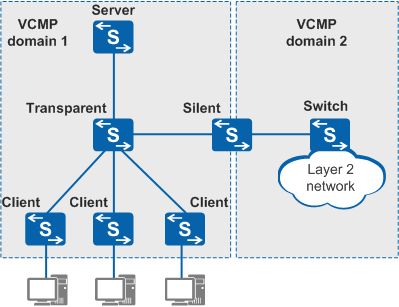Basic Concepts of VCMP
VCMP uses a VCMP domain to manage switches and determine attributes of switches in the VCMP domain based on roles. VCMP defines four roles: server, client, transparent, and silent. Figure 1 shows VCMP domains and roles in the VCMP domains.
VCMP Domain
As shown in Figure 1, a VCMP domain is composed of switches that have the same VCMP domain name and are connected through trunk or hybrid interfaces. All switches in the VCMP domain must use the same domain name, and each switch can join only one VCMP domain. Switches in different VCMP domains cannot synchronize VLAN information.
A VCMP domain specifies the scope for the administrative switch and managed switches. Switches in a VCMP domain are managed by the administrative switch. There is only one administrative switch and multiple managed switches in a VCMP domain.
VCMP Roles
VCMP determines attributes of switches based on VCMP roles. Table 1 describes VCMP roles.
VCMP Role |
Function |
Remarks |
|---|---|---|
Server |
The VCMP server synchronizes VLAN information to other switches in the local VCMP domain. |
If VLANs are created or deleted, or VLAN names or descriptions are changed on the VCMP server, the configurations are synchronized to the other switches in the VCMP domain. |
Client |
A VCMP client belongs to a specified VCMP domain and synchronizes VLAN information with the VCMP server. |
If VLANs are created or deleted, or VLAN names or descriptions are changed on a VCMP client, the configurations are not synchronized to the other switches in the VCMP domain. VLAN information on the VCMP client is overwritten by that sent by the VCMP server. |
Transparent |
A VCMP transparent switch does not affect other switches in the local VCMP domain and is not affected by VCMP management behaviors such as VLAN creation and deletion. |
A VCMP transparent switch transparently forwards VCMP packets to only trunk or hybrid links. If VLANs are created or deleted, or VLAN names or descriptions are changed on a VCMP transparent switch, VLAN information on the VCMP transparent switch is not affected by that on the VCMP server and is not synchronized to the other switches in the VCMP domain. In this way, some switches that do not need to be managed by VCMP can forward VCMP packets. |
Silent |
Deployed at the edge of a VCMP domain, a VCMP silent switch does not affect other switches in the local VCMP domain and is not affected by VCMP management behaviors. The VCMP silent switch prevents VCMP packets in a VCMP domain from being transmitted to other VCMP domains. |
A VCMP silent switch directly discards received VCMP packets. If VLANs are created or deleted, or VLAN names or descriptions are changed on a VCMP silent switch, VLAN information on the VCMP silent switch is not affected by that on the VCMP server and is not synchronized to the other switches in the VCMP domain. |

- VCMP transparent and silent switches do not belong to any VCMP domain.
If an edge switch in a VCMP domain needs to be managed, configure the edge switch as a VCMP client. To prevent VCMP packets in the local VCMP domain from being transmitted to other VCMP domains, disable VCMP on the edge switch interface connected to other VCMP domains.
